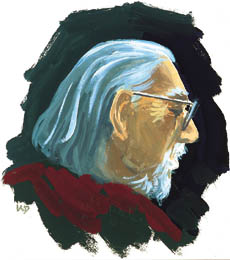IN the nineteen-twenties William Archer wrote a rather insulting article titled Is India Civilised? Stung by the author's groundless reasoning, a young scholar wrote a fiery rejoinder: 'We are abused with being wanting in truth, honesty and integrity; with being avaricious and perfidious; in short with being void of the noble qualities and generous feelings that ought to adorn a nation.... Let us tell the proud Europe that it will ever be the boast of Asia to have given birth to all the religions and sublime morality of the world.' That was Ananda Kentish Coomaraswamy, a man of varied talents and interests — a scientist, nationalist, interpreter of Indian art, and literary critic who often said that he was too Indian in his ways of thinking, and that his love for India was his destiny.
 Born in Ceylon (Sri Lanka), his father was an enlightened intellectual, and his mother a very accomplished English woman. He was named Ananda after the famous disciple of the Buddha, and Kentish refers to the place his mother hailed from. He went to the Wycliffe College, and later to the University of London. When here was a mere lad of twentytwo he wrote Ceylon Rocks and Graphite for the quarterly journal of the Geology Society. He might have blossomed into a great scientist because his discovery of Thorianite was acclaimed as a first rate one, but with more than 500 publications, and innumerable research papers on Indian, Indonesian, and Asian art during his thirty-year association with the Boston Museum, he became an international authority in art, aesthetics and culture.
Born in Ceylon (Sri Lanka), his father was an enlightened intellectual, and his mother a very accomplished English woman. He was named Ananda after the famous disciple of the Buddha, and Kentish refers to the place his mother hailed from. He went to the Wycliffe College, and later to the University of London. When here was a mere lad of twentytwo he wrote Ceylon Rocks and Graphite for the quarterly journal of the Geology Society. He might have blossomed into a great scientist because his discovery of Thorianite was acclaimed as a first rate one, but with more than 500 publications, and innumerable research papers on Indian, Indonesian, and Asian art during his thirty-year association with the Boston Museum, he became an international authority in art, aesthetics and culture.
On August 15, 1947, he proudly unfurled the Indian flag in Boston and said: 'Our problem is not so much of rebirth of an Indian culture as it is one of preserving the remains of it. The culture is valid for us not because it is Indian as because it is culture.... Freedom is the opportunity to act in accordance with one's own nature. But our leaders are already denatured — Indian in blood and colour but English in tastes, in options, in morals and intellect.'
He and his wife had planned to settle down in India and devote the rest of their lives to Indian art and culture, but this was not to be as he died on September 9, 1947, in Massachusetts, leaving behind an awesome scholarly output which inspires young scholars to this day.
http://www.tribuneindia.com/2000/20000102/spectrum/main2.htm
No comments:
Post a Comment